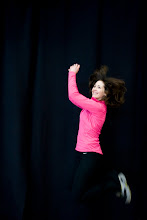In any movement you are only as strong as the weakest muscle. Now that your core is strong and no longer the weakest link or you did the plank to push-up test and you know it's your shoulders and chest let's discuss what exercises you can do to improve the strength of your shoulder muscles.
Your shoulder muscles are more than your deltoids. It is very mobile joint i.e. you can make big circles with your arms, and it is also unstable. Small muscles are in place to help support this joint and help create a more stable shoulder joint. However, these smaller muscles need special attention to keep them strong enough to support the joint.
The small muscles are better known as your rotator cuff (RC). The RC is a group of four muscles that work together to hold the humerus (upper arm) bone in its socket. Since there is not much of a socket, it's more like a golf ball on a tee, the muscles are required to do the heavy work of holding this joint together.

It is estimated that 67% of the population will have trouble with their RC at some point during their lifetime (1) so even if you are not interested in doing push-ups, these are beneficial exercises. Here are two exercises you can do to improve the strength and endurance of your external rotators (commonly weak RC muscles) which will help you DO MORE (or one) PUSH-UPs.
External Shoulder Rotation:
 Start with your elbow at 90degrees and, ideally, a towel under the arm. Hold a band and rotate the arm out. Don't allow the elbow to "wing". If you drop the towel you know you are winging rather than rotating. Go as far as your shoulder allows you to rotate without losing posture and without pain.
Start with your elbow at 90degrees and, ideally, a towel under the arm. Hold a band and rotate the arm out. Don't allow the elbow to "wing". If you drop the towel you know you are winging rather than rotating. Go as far as your shoulder allows you to rotate without losing posture and without pain.
This is the basically the same exercise except in side lying and using a light dumbbell. Most people only need a 1-3# dumbbell. Notice the towel under the arm again. Elbow is still bent at 90 degrees and keeping the wrist rigid, rotate the arm up as shown in the picture.
These exercises should be done three times per week and do 3 x 15-20. That is 3 sets of 15 - 20 repetitions.
Good Luck with theses exercises.
Marie
p.s. The next part I'll show you variations of the push-up!
1. Implications for Specific Shoulder Positioning During External Rotator Strengthening
Kolber, Morey J; Beekhuizen, Kristina S; Santore, Todd; Fiers, Hunter
Strength & Conditioning Journal. 30(4):12-16, August 2008.
doi: 10.1519/SSC.0b013e31817764ae





No comments:
Post a Comment